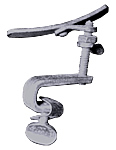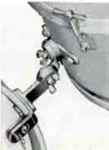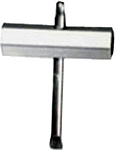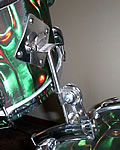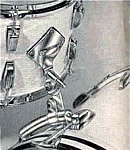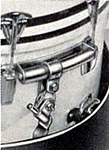
A
Look At Vintage American Tom Holders
"During
forty-some-odd years of playing drums, I've taken notice
of details on drum sets for various and obvious reasons.
Never owned a shop or did all that much in restoration
and repair, but drummers tend to be mechanically inclined.
I'm hardly qualified to call myself a 'drum historian,'
though. I just play one on stage. Researching information
is a frustrating hunt sometimes, but the education is
always rewarding.
Trivial matters are like the prizes in a Crackerjack box.
What year did the first lug casing appear in? Who had
it first? Who was first with metal floor tom legs instead
of cradle stands? Annual catalogs can be misleading. Sometimes
new items appear a year or two late. Often a maker would
use the sames photos and illustrations for several years
in a row. Written histories and biographies need to be
cross-referrenced to help eliminate misinformation. And
not all that much can be found in patent searches.
I took a look into vintage tom holders and compiled this
comparative detailing. With as much data as I could gather,
and some fair bit of conjecture, I covered mainly vintage
American hardware, delving only a little into the more
modern stuff of unlimited choice today. If anyone has
anything to add, any corrections, any further information,
please - add it in here. Through a community of drummers,
we could make these pages into a valuable resource."
|
| As
modern toms evolved from the old style Chinese tom-toms
used with traps sets, they were still held in the same positions
over the bass drum. Mounting hardware evolved with larger-sized
toms, better ways of securing them in place grew with them.
Link hoop clamp holders were designed to be angled and tilted
to any position a player desired. As toms grew larger, link
holders also became bigger, stronger, and more complex. |
|
Leedy
1920s hoop clamp link tom-tom holder |
Swivelling
shell mounts had toothed joints (Photo 2) with carriage
bolts and big wing nuts for the convenience of not needing
a wrench. But with larger, heavier toms, thumb screws weren’t
reliable for enough torque, so hex wrenches became a necessity.
A 7/16” socket (Photo 3) was made as a key for the
standard 1/4” hex-head bolts and retainer nuts that
were used on most makes.
|
Ludwig
1930s hoop clamp tom-tom holder |
7-16
inch socket rail key |
|
|
Photo
2 |
Photo
3 |
The
wrench provided a more reliable torque, though thumb screws
were still used for the hoop clamps. A convenient innovation
in the early 1940s was the shell-mounted bracket designed
to accept a tongue or spade, which allowed the tom to easily
be slid on or off. (Photo 4) But link holders were all still
hoop-clamped designs until around 1951, when Bill Mather,
a New York Slingerland dealer, designed a permanent shell-mounted
link. Walberg & Auge it built for Slingerland as their
Ray McKinley mount. Based on the idea of the earlier console
rails, the McKinley holder used only a portion of a rail,
enough for one tom. It ultilized a spade to accept the slip-on
diamond plate shell mount. (Photo 5) Walberg & Auge
then began producing their own version of the design, calling
it a rail consolette. As a generic utility, this hardware
was available to every major drum manufacturer, and each
would apply their own distinct names and catalog part numbers
over the years.
|
Rogers
1941 hoop clamp link tom-tom holder |
Slingerland
1952 Ray McKinley (W&A) 4-bolt rail consolette |
|
|
Photo
4 |
Photo
5 |
Walberg
& Auge rail consolette exploded view-vintagedrumguide.com |
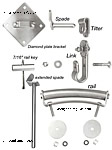 Photo
6
Photo
6
|
Slight
variations would appear from time to time, in either the
tilter or the rail mounting. The most common version was
Walberg & Auge ’s two-bolt mount, which offered
a sleek-looking plated rail mount. A perforated disc on
the tom tilter worked like a toothed gear, where a nub in
the tilter clamp would rest in one of the holes to prevent
it from slipping. (Photo 6) By the mid-1950s, this version
was found on Ludwig, Rogers, Gretsch, Leedy, and Slingerland.
It was also used by Camco, and by the mid-level E.W. Kent
drum company.
|
A
useful accessory to the basic rail consolette system was
an extended spade, used with smaller-sized bass drums to
lift the tom to an appropriate height. It was a favorite
for the bebop players using 18” bass drums. (7) Likely
it was a lot less costly to produce an extended spade rather
than a taller link assembly.
|
In the 1957 WFL / Ludwig catalog, their new “Shelmont”
shell - mounted rail consolette (by Walberg & Auge)
was listed among their exclusive features in hardware offerings.
(Photo 8-9)
|
Ludwig
1957 Shelmont rail consolette - vintagedrumguide.com |
Ludwig
1957 Shelmont rail consolette 2 - vintagedrumguide.com |
|
|
Photo
8 |
Photo
9 |
The convenience of the slip-on / lift-off diamond plate
tom bracket made for quick and easy set ups, and the rail,
with the link folded down, would fit into snug cases. The
rail key was needed for both the link and the tilter nuts,
making adjustments simple and secure. With a little care,
the system worked well enough, although a common problem
was players losing their rail key and using pliers to tighten
the nuts, which inevitably led to rounding and stripping
them. Experienced players knew to keep an extra rail key
and a couple of spare nuts on hand.
|

|
|


